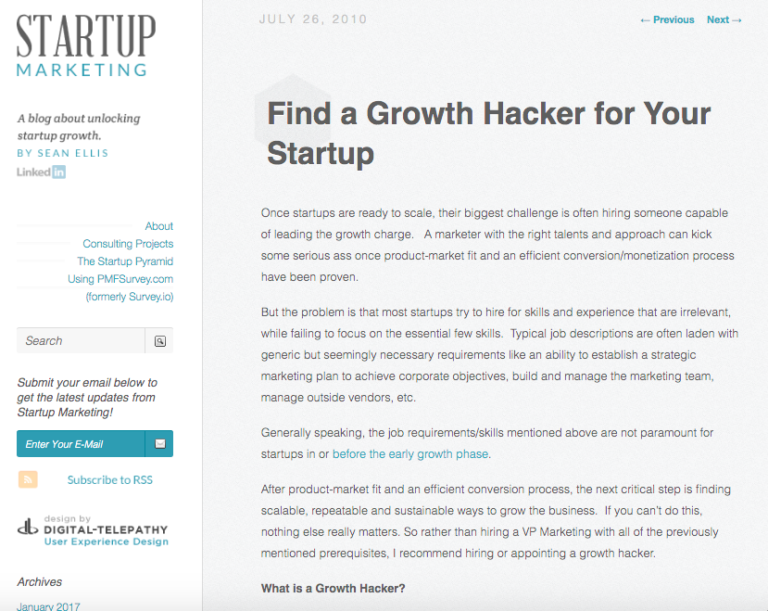Growth Hacking: the complete guide

What’s Growth Hacking?
Growth Hacking is a marketing process or methodology that aims to accelerate the growth of a company quickly and at minimum cost.

From developing integrations to strategic support, from creating creative concepts to optimizing results.
Growth Hacking is a trick or stratagem to grow. This could make you think of something impromptu (or the so-called “pirate marketing”), but that’s not the case: Growth Hacking follows a strict framework where every idea and investment get tested in advance.
This is where Growth Hacking becomes revolutionary.
How Growth Hacking works: techniques and strategies
Facebook, Twitter, LinkedIn, Airbnb, Dropbox, Reddit, and GoPro are just a few examples of startups which, using Growth Hacking techniques, have experienced record expansion figures in less than a decade.
Professionals achieved such a result by replacing standard marketing handbooks with a new methodology that builds on product development.
What are Growth Hacking strategies?
Unlike traditional marketing, Growth Hacking doesn’t feature standard strategies. Rather, this approach indicates a path to follow based on creativity and experimentation.
The goal of growth
Starting to consider the impact of a product on the user base makes it much easier for the entire team to reflect on growth. And when the team starts experimenting, then growth accelerates.
It’s a permanent process: continuous experimentation at every level of the strategy leads the marketing team to the Growth Hack. This perfect equation opens up to a quick, minimum cost and the highest possible growth for the business.
Experimenting is vital to growth—you need to test your hypotheses since you don’t know how people will react to product changes.
The Growth Hacking Funnel
The Growth Hacking methodology includes process and development stages that are peculiar. Let’s understand how it works by introducing the Pirate Funnel. This name comes from the acronym of each level’s initial letters, bringing to mind the most characterizing expression of pirates: AARRR.
The Pirate Funnel unfolds through the following phases:
- Acquisition
- Activation
- Retention
- Revenue
- Referral
The Growth Hacking Funnel is key in establishing your priorities and deciding where to invest available resources. Each funnel phase includes specific strategies.
The history of Growth Hacking
In 2010, marketer Sean Ellis coined the term “Growth Hacking” to describe a new, more operational and less dispersive approach to marketing.
Growth Hacking emerged to help startups, which have notoriously low budgets and staff, but quickly ignited the interest of companies of all sizes.
Ellis was a leading figure in Silicon Valley at the time. In fact, his revolutionary systems, processes, and mindsets have allowed various technology startups to accelerate their growth.
Ellis’ idea was to offer a framework for companies to grow independently. Unfortunately, however, as soon as a company stopped directing the project, it also stopped growing.
This prompted him to post a job ad: “Find a Growth Hacker for Your Startup”.
This was the first occurrence of “growth hacker”.

Ellis wasn’t looking for classic marketing skills, so his ad explained what a growth hacker is (we’ll learn more in the paragraph entitled “Growth hackers: who they are and what they do”).
Digital marketing vs. Growth Hacking: the differences
Growth Hacking has the company’s growth as its sole objective. For marketing, however, growth is just one of the many objectives to be pursued.
Now, you may wonder about the practical differences between Digital Marketing and Growth Hacking.
Here they are:
- approach: Growth Hacking, with a more operational approach, focuses on the last steps of the sales funnel. On the other hand, traditional marketing focuses its efforts on the funnel’s initial levels (awareness and branding).
- method: Growth Hacking starts from a creative phase, enforces a quick testing rationale, and implements the test-sorted best performing solutions.
- budget: This is meant as not just quantity but also a way of allocating resources. Traditional marketing allocates the budget by campaign. Instead, Growth Hacking splits it among different ideas to be quickly tested. Based on the test results, investment in the most promising increases.
- marketing activity concept: Traditional marketing starts from the product, while Growth Hacking starts from understanding its user base in order to develop products that are easier to sell.
Diving deeper into the difference between Digital marketing and Growth Hacking, we notice that they share the same online channels and tools, that is SEO, PPC, Email Marketing, etc. But Growth Hacking does so with a more agile, creative, and experimental mindset.
Growth hackers: who they are and what they do
A growth hacker designs, implements, and oversees marketing strategies that allow a company to boost sales and customer engagement.
H3 What a growth hacker does:
- conducts market research
- performs A/B tests
- analyzes data
- identifies industry trends
- collaborates with UX/UI teams
What kind of character, personality, skills, and experience do growth hackers need?
Growth Hacking requires the ability to combine strategic vision with practical execution and analysis. So a good growth hacker must have a creative mind, strong analytical skills, discipline, and think on their feet: adapting to sector changes or negative test results is key.
“A growth hacker is a person whose true north is growth.”
Sean Ellis
This is the first definition of a growth hacker
But what does “north is growth” mean? It means that every decision, tactic, and strategy adopted by a growth hacker aims at growth.
What background is more suitable for a growth hacker? Engineering or sales?
As Ellis pointed out, the background isn’t key. An aspiring growth hacker must have 3 main skills:
- the ability to take on growth;
- an entrepreneurial drive;
- an ardent desire to connect the target market with the solution proposed by his/her company.
-
What do you study to become a growth hacker?
Given the success of companies that have implemented Growth Hacking, more and more CEOs are looking for professionals who can apply this work methodology.
Do you want to become a growth hacker? There is currently no “Growth Hacking Degree.” But if you have a degree in Marketing or Business, then you may have more career opportunities. Mastery of Google Analytics and other data collection software is also crucial.
Experience in digital marketing, hence expertise in SEO, online advertising, content marketing, and social media marketing work are also key requirements. In fact, it takes knowing the rules to imagine how to break them—which is what a growth hacker does.
As we’ve outlined, a growth hacker is a professional with specific skills—a creative, open, and analytical mind with an excellent ability to adapt to change. These skills can be learned and, above all, taught.
How to become a growth hacker in 4 steps
- Step 1: Invest in your training. Attend specialization courses, read books on the subject, and follow forum and group discussions where growth hacker communities gather.
- Step 2: Work on your technical skills. Proficiency in coding, as well as UX/UI and analytics software, will be very useful.
- Step 3: Get experience. Try out small projects, explore unusual paths, collect data, and study your results to establish patterns that can be replicated on increasingly larger businesses.
- Step 4: Find a mentor to guide you through the best Growth Hacking strategies, and network with other professionals. For example, why not join growthhackers.com, the largest international growth hackers community founded by Sean Ellis and his long-time partner, Morgan Brown?
Best Growth Hacking books to read
In just over 10 years, dozens and dozens of books have been written on the subject, from beginner to more advanced.
Here are the must-have Growth Hacking books:
- Hacking Growth, by Sean Ellis This gathers the basic concepts of the methodology, plus the hacks of the different Growth Hacking Funnel phases.
- Don’t Make Me Think, by Steve Krug This book helps you think about user interface to improve your UI designer skills.
- Growth Hacking Mindset: There is No Innovation Without Experimentation, by Raffaele Gaito This book collects 25 case studies from Italian companies of all sizes and sectors that have applied Growth Hacking.
- Traction, by Gabriel Weinberg & Justin Mares This Growth Hacking book investigates why some startups are successful and others aren’t.
- The Growth Handbook, by Des Traynor, Karen Peacock, and Andrew Chen This delves into the current subscription-based economy by explaining how to experiment with growth, plus detailing the most common mistakes.
Growth Hacking feeds on lateral skills and innovative approaches to marketing problems. Broaden your training with strategic handbooks, specialized texts, and books with case studies from the best growth hackers.
Growth Hacking courses
Courses are a great way to learn Growth Hacking techniques and the mindset behind this approach. There are courses of all types, from beginner to more advanced, online or face-to-face.
Check out the Growth University at growthhackers.com with its vast array of excellent specialization courses on Growth Hacking. Some resources are free, such as the “LinkedIn Ultimate Growth Hacking Manual” course.
Other courses cost around €100–300, with a 15% discount option if you buy more courses (“Bundle”).
The platform also markets Masterclass passes and exclusive video conferences on Growth Marketing.
The MailUp Academy section offers you a free course on “Growth Hacking a.k.a. Growing by Experiment: Techniques, Tools, and Case Studies to Develop Your Business with Growth Hacking” by Raffaele Gaito.
Find other basic and advanced Growth Hacking courses on Udemy, Ninja Academy, Lacerba, and Learn.
Growth Hacking for startups: aspects to consider
Startups must quickly achieve exponential and sustainable growth from a small budget. This makes them ideal for taking unconventional paths.
Startup experiments are a quick way for growth hackers to get what will make the business grow and what won’t, so to invest resources only where the results are positive.
Furthermore, startups perfectly fit this setting because they don’t have a rigid structure like that of large companies. Here, the traditional management of product development and marketing can be overturned with much more ease than in already established companies.
Does Growth Hacking Really Work? The most sincere answer lies in the results achieved by companies such as LinkedIn, Uber, Dropbox, and Airbnb. They were born as startups and are among the most powerful companies on the market today, have an international status, and are listed on the stock exchange.
How to create a Growth Hacking team
Creating a Growth Hacking team is now a hot topic for startups: more and more companies post invitations for growth hackers and growth marketers to join their team on specialized sites (such as AngelList).
What is a growth team?
In the book, Hacking Growth, Sean Ellis and his long-time partner, Morgan Brown, say that a growth team is cross-functional, collaborative, and made up of experts in marketing and sales—but also programming, analysis, and product management.
How to build a Growth Hacking team and the professionals you can’t do without
The team in charge of designing, developing, and monitoring Growth Hacking strategies must have highly qualified, versatile, and courageous data-led people.
If your company is a startup, then you may have some resources to hire all the professionals that your Growth Hacking team needs. In this case, prioritize the following profiles:
- Head of Growth
- Coder
- Data Analyst
- UX Designer
Steps to form a Growth Hacking team
- Set your business growth goals.
- Define your KPIs.
- Choose your Growth Hacking team model: independent (like Uber and Facebook) or functional (like LinkedIn, Pinterest, Dropbox, or Twitter).
- Search for and hire the right professionals.
- Cultivate a growth-friendly culture within your team.
- Expand your Growth Hacking team once your startup takes off.
Growth Hacking with an agency
If there’s no room in your current budget to create a Growth Hacking team, then you can rely on an agency specialized in this type of activity.
Here you’ll find trained and experienced professionals who can plan and manage the experimentation process that you need to accelerate the growth of your business. So on hand, you’ll have a team of growth hackers experienced in companies of different sizes and sectors without having to hire them directly.
Growth marketing agencies bring together marketing, sales, and technology services with a global vision and centralized leadership. They analyze your business’ issues and think about its Growth Hacking Funnel. Then, together with you, they define SMART growth objectives and the KPIs to assess.
Growth Hacking: practical applications
Growth Hacking and social media
The Growth Hacking methodology may also let you quickly grow your social network audience, not only in quantitative but also (and above all) qualitative terms.
Growth Hacking and Email Marketing
Email Marketing is an excellent Growth Hacking tool thanks to its low investment and ease of implementation. Growth Hacking solutions are based on the type of business and the actual user base.
As with other fields, the ability to measure and analyze data combined with the use of machine learning and Automation processes, are an indispensable ally.
Growth Hacking and WordPress
WordPress is the perfect Growth Hacking tool: flexible and controllable in every aspect, it lets you carry out any type of experiment like A/B tests on landing pages, marketing campaigns, and the optimization of buttons, titles, blog post structures, etc.
Loved by search engines, WordPress is mobile-friendly and, thanks to thousands of available plugins, lets a Growth Hacking team test different versions of a site to improve user experience and conversions.
Growth Hacking FAQ
What’s better: Growth Hacking or Traditional Marketing?
Growth Hacking and traditional marketing often overlap. The latter focuses on selling a company’s products or services, while Growth Hacking provides an overview of the business and a more holistic approach to the problem of growth.
Traditional marketing is more suitable in the early stages of the funnel (awareness and branding), while Growth Hacking can make a difference in the activation, retention, revenue, and referral phases.
How often should Growth Hacking be implemented?
Growth Hacking is neither a tactic nor a strategy. It’s an approach: an ongoing process which, ideally, never ends. To achieve exponential and sustainable growth over time, tests must be performed continuously, and their results must be measured before taking any action.
How big should the Growth Hacking budget be?
Growth Hacking was created to help companies with few resources, such as startups. However, it can’t be developed without an adequate budget.
You can start with a small budget to conduct the first tests, and then increase it as you start to get the first results and economic returns.
Is Growth Hacking for startups only?
Not at all. Startups have small budgets and high hopes. They show us how we can accelerate the growth of a business when we proceed by testing and thinking about data. However, Growth Hacking can and should also be applied to medium and large companies to allocate the budget in a more effective and profitable way.